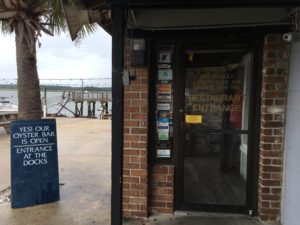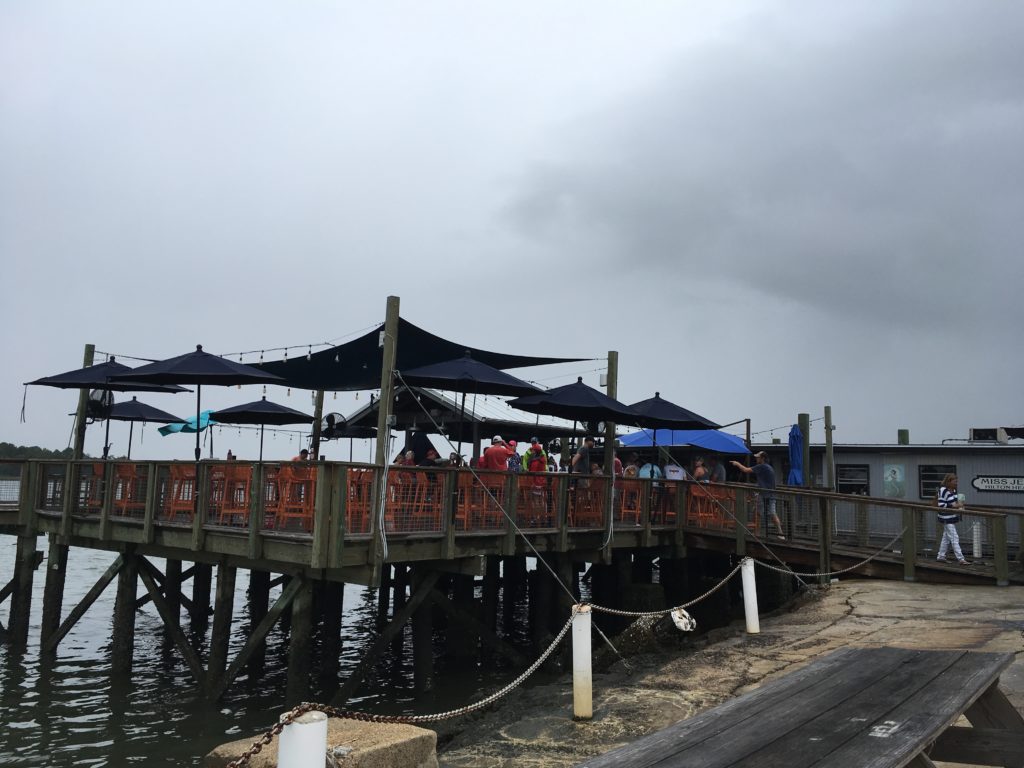Settled on a tiny peninsula overlooking Hilton Head’s Skull Creek is a restaurant built on what was once called “the shell pile.” The Hudson’s poured fill dirt and concrete slab onto the heap of shells from their packing facility. In the 1920s, this little corner was all docks. Now, a century later, it is home to the island’s greatest treasure.
When I arrived at Hudson’s Seafood on the Docks on an early Wednesday morning for this interview, the restaurant was not yet opened. I called my subject to see where he was.
“Hi! Come around the back! I want to show you something!”
Curiously, I wandered to the rear of the building, up the ramp to the dock. A barback preparing for a day’s service motioned me towards a tall white boat. I was greeted then by the firm handshake and sun-kissed features of Andrew Carmines, Hudson’s owner and general manager.
“I’m so glad you could get here this early! I thought this was a good place to start. Check this out—today’s load in just got here.”
Roughly a thousand pounds of fresh shrimps were bagged up on the boat.
“We hope to have these on plates today.”
I was stunned. Never before had I seen Hilton Head’s freshest and finest local shrimp in such a large quantity. He was right. This was the perfect place to begin our interview.
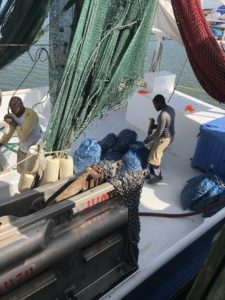
Andrew Carmines Has Made His Family Business Into the Staple of Hilton Head Island
100 Years of Tradition
We parked ourselves at a high-top table overlooking the finest view on the island, a view that in just nine hours would be painted in streaks of pinks and purples and reds, and enjoyed by hundreds of customers, both local and tourist in variant. I could envision all the happy memories that had occurred at these tables. Some were my own, having grown up on that very shore. There are several other restaurants on this marsh, but Hudson’s is the only true mom and pop shop. Singular, self-providing and self-sustaining.
Andrew hashed out an image of the oyster packing facility of the ‘20s. A peninsula of loose shells and boats. A landing where a restaurant couldn’t even imagine being born.
“The men in the native island community would row out on oar-powered skiffs called bateaus and they would harvest oysters. The women and children would shuck the oysters, and then they would pack the meat in steel barrels, and then the meat would get iced and shipped up to Charleston, where then it would be shipped to Boston, New York, and Chicago.”
The property was originally owned by the Hudson family, a family of oysterers. The property next door belonged to the Toomer family, who were mostly commercial crabbers. In the 1950’s, shrimping became a trend, and both families began working that industry into their businesses. In 1967, Benny Hudson opened the restaurant in a very different form than what we know it to be today. After eight years, in 1975, he sold the business to Andrew’s parents. Hudson’s has remained the Carmines’ property since then. Andrew still collaborates with the Toomers, who continue to operate the very shrimping boats that Andrew showed me at the top of the morning.
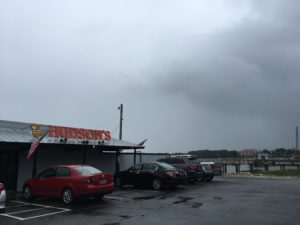
Adjusting to the Times
Brian and Gloria Carmines were active in shrimping for a long time, selling to markets such as New York’s Fulton Fish Market for years. When imports hit in the ‘90s, it drove the price of shrimp through the roof and put many shrimpers out of business.
“At one time we had 35 boats that docked at this dock, and this dock in 1988 packed two million pounds of shrimp. Last year, the whole state of South Carolina packed less than two million pounds of shrimp.”
Andrew explained that their shrimpers have to be very savvy. The product’s perishability and the price of fuel have led them to their methods of acquiring their product. His fishermen do a lot of traveling to where the best product can be caught. Still, the favorite stuff comes from Hilton Head’s waters, and Andrew has made it his mission to make that the most common feature of his plates, even starting his own oyster company to supplement that product.
Shell Ring Oyster Company
A man of many talents, Andrew’s impeccable taste for the local flavor is complemented by his knowledge of what dwells beneath. He and his partner Rob Rowe founded Shell Ring Oyster Company in 2013. Their 12-acre lease on the north end of neighboring Pickney Island harvests cluster oysters, as well as single selects. Andrew chose the area because of the nutrient value in the water, despite marring from hurricanes in the last few years.
“(We produce) baby oysters which we call seed – I’m convinced, because you don’t feel so bad when you kill them – and put them in cages and poly grow-out bags and grow them to maturity over the course of a 14, 15-month period.” These are the single select oysters that are cultivated to perfection and consumed as oysters on the half shell. The single selects are in their prime for about five months of the year, November through March; whereas, a cluster oyster might only be found in January and February. “Uniquely here in the Lowcountry, we have these oysters that grow in these big clumps and clusters, which is why oyster roasts were born—a good way to use a resource that’s undervalued. The value is tremendous. I don’t think people realize how lucky we are. My mom always said ‘Money doesn’t grow on trees,’ and I say ‘No, it grows in lumps on the marsh!’” Andrew believes that Beaufort County has the largest population of oysters in the United States, and he intends to capitalize on those offerings.
“I always say I could live on oysters and champagne. And I know what qualities I love in an oyster, but it’s so hard to verbalize,” I tell him.
“I’m a real snob about oysters,” he admits, “But I don’t know all the descriptive words, like a lot of people do.” He then explains to me that while different variants may be more resounding to individuals, they are all biophysically the same critter. There’s no difference in the genus or species. What makes an oyster different is everything that is its environment: the location that that oyster grows, the bottoms structure, the wave action, the minerality, the tide influence, the prevailing wind direction, the salinity content.
“I think that’s what people love about it, because they kind of carry with them a sense of place, so if you spent summers on Long Island and remember going water skiing, a Blue Point is gonna be resounding to you. You’re gonna love it.”
Devastation and Recovery
As Andrew talked me through the marine biology necessary to understand how Hudson’s acquires their freshest product and the way that the waters impact the lives of the oysters, I remember a visit to the island in 2016. Crossing the bridge, I was terrified to see the devastation from Hurricane Matthew, which had shut down the island for the past several weeks. The damage at Hudson’s was unlike anything I had ever seen before. The dock on which Andrew and I sat had been completely blown off. Doors no longer hung from their hinges. Shingles floated in soggy disarray in the small parking lot. The rebuild should have taken months. Hudson’s reopened in a matter of a few weeks.
“The staff had a lot to do with that. First off, a lot of people don’t know this, but my dad, who I lean on for advice frequently, had some major health problems that fall. And obviously, the island was shut down for weeks after Matthew. And he couldn’t get to see the doctor. Finally, when they did, they found out that he had a tumor the size of a fist behind his left eye, and it was messing up his brain, so I was kind of left to my own devices, and my thought process was ‘We’ve gotta get this place back open.’ Because what if the roles were reversed, and I was me, with my three kids and all my bills, and I was working as a server at Hudson’s? Not the manager, not the owner, but a server, and I’m all of a sudden out of work? And, it really struck me as scary. I was worried for my employees.”
“We immediately cut all the vacation checks for that year. If anybody was even close to making the amount of hours (necessary to receiving an early check for the holidays), we gave them the vacation check to tide them over at least until we could figure out a decision. The second thing we did was I held a meeting, and it was the Friday four days after the hurricane had hit, and I said, ‘Everybody that wants to come, come.’ Obviously, they were super nervous that I was gonna tell them that we were gonna be closed indefinitely, so I said ‘Look, this is gonna be a rough few weeks, but it doesn’t have to be a few months. It can be a few weeks. If you are wanting to work, I will pay you as many hours as it takes to get the restaurant re-opened, and I’ll pay everyone at the same rate of $20 an hour, and let’s get this thing reopened.’ And not one person, not one person didn’t show up.”
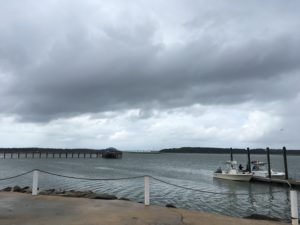
Shell-to-Table
Andrew took the reins from his parents several years ago and has since made the property his own, operating under the same core standards of fine and family-friendly service with a local flair, but adjusting to accommodate the industry standards of the contemporary dining experience.
“When my parents were operating the restaurant in the ‘90s, there wasn’t this major emphasis on farm-to-table and fresh this and fresh that. People cared what they were eating but it was much different. There wasn’t this intense focus on food and chefs and culinary arts. So in some ways, I think we were farm-to-table before farm-to-table was cool.”
He explains that over time, his parents got rid of many of their oyster leases to remain competitive price-wise. When Andrew came back into the picture, he pushed them to reconsider their product resources.
“I kind of just said ‘I don’t care what it costs. We’re gonna do it. And we’ll work overtime on getting that price down based on producing it ourselves, processing it ourselves.’ And my parents and I, rightfully so, had some very heated discussions about the bottom line, and lifestyle changes because of the fact that we were spending more and not necessarily charging more at the time.”
But Andrew always knew his strategy would work out in the long term, and it has. “I think people are starting to come around on the fact that we’re obsessed with quality, and I think that that message tells your customers that you care not only about what it is that you’re doing, and take pride in what you’re doing, but that you care about them.”
I think about the boats being unloaded to the back of the restaurant from the dock. Those thousands of shrimp, which were undoubtedly being cleaned and prepared to be plated as we spoke. The restaurant is known for its shellfish but does great work with finned fishes as well. “I’m real picky about seafood. I only eat the stuff that I know is hours old as opposed to days old. Yesterday we unloaded a long lining boat and I know the swordfish and the black sea bass came off that boat, so I’ll be having swordfish and black sea bass for lunch today. People will tell me all the time, ‘I don’t like swordfish,’ and I say ‘Well, you’re gonna try it today. And if you don’t like it, I’ll get you whatever you want on the menu free of charge.’ And sure enough, every time they taste it, they say ‘This is the best piece of fish I’ve ever had.’”
Keeping it Fun
“I’ve got a five-year plan to put in an oyster hatchery, so we’d actually produce the oyster seed on site, and distribute it into the wild. The cool thing about that is that we can really make a difference on water quality,” Andrew tells me. Sustainability, while obviously important, is such a trend right now, and Hudson’s has been doing their part to whittle away at the little things while Andrew works on this new project. They’ve started with eliminating all of their plastic to-go stuff, as well as their plastic straws. “I think just continuing to chip away and continuing to do things a little bit better every year is what makes it exciting and fun.”
And the restaurant is so much more than just high quality, sustainable dining and beautiful views. Palpable at Hudson’s are feelings of joy amongst an excited and passionate staff—a staff that cares so much about their workplace that they got their hands dirty to help revive it after one of the most historically devastating events to ever impact the island. Sure, part of that positive energy must come from the rush of knowing they are a part of one of the most popular operations in the community, but for Andrew, it’s more than that.
“I think the thing that makes it interesting to me and the reason why we’ve gotten back into the shrimp boats and the soft shell crabs and the oysters, is that every time we add something new, it makes it like it’s ALL brand new to me. It keeps it fresh and interesting. I would have driven myself nuts ten years ago if I was just running a restaurant and doing the status quo. So it’s just so fun to develop new ideas and take it from a legal pad to the plate on the table. It’s just a lot of fun.”
“What’s your favorite way to eat an oyster?” I ask him.
“Plain. Raw. With nothing on it. It’s just so wonderful by itself.”
